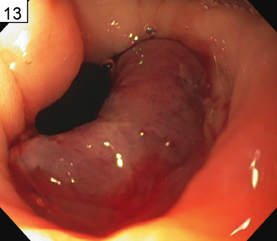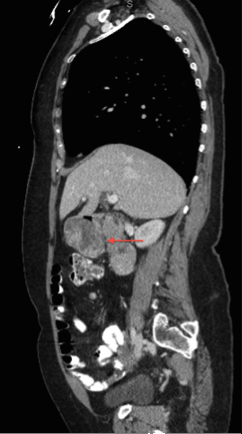AN UNUSUAL CASE OF PRIMARY DUODENAL LIPOSARCOMA PRESENTING WITH CHRONIC GASTROINTESTINAL BLOOD LOSS
Eric Nellis1, Robert Andrews*1, Abdul Aleem1, Ronald Bross1,2
1Gastroenterology, Lehigh Valley Health Network, Allentown, PA; 2Eastern Pennsylvania Gastroenterology and Liver Associates, Allentown, PA
Introduction:
Liposarcoma is a malignant growth most commonly found in the retroperitoneum and extremities. We present a rare case of primary duodenal liposarcoma in a patient with symptoms of chronic upper gastrointestinal blood loss.
Case:
A 59 year-old female presented to the emergency department with a three-month history of progressive symptoms of anemia and black stools. Upper endoscopy performed two years before showed reflux esophagitis and gastritis. On arrival, the patient had a blood pressure of 128/74 mmHg and heart rate of 83 bpm. Other than an ill-appearance and skin pallor her physical exam was normal. Hemoglobin was 6.9 g/dL from a level of 13.0 g/dL eight months before. An upper endoscopy showed a submucosal, friable mass on the posterior wall of the duodenal bulb. No hemostasis was required. Biopsies were consistent with a high-grade sarcoma. Immunostains were positive for MDM2, most consistent with a diagnosis of dedifferentiated liposarcoma. Computed tomography of the chest, abdomen and pelvis confirmed the presence of a duodenal mass 5.2-cm in its greatest dimension with no other evidence of metastatic disease. She was transfused 2U of packed red-blood cells with adequate response and was discharged. One month later she underwent duodenal resection with a distal gastrectomy and roux-en-Y reconstruction. Tumor resection margins were negative without recurrent symptoms to date.
Discussion:
First described by Virchow in the 1860s, liposarcomas are the most common soft tissue sarcoma in adults. Predominantly known as malignancies of retroperitoneal origin, dedifferentiated liposarcomas usually present after the neoplasm has expanded to adjacent organs.
Primary small bowel liposarcomas are extremely rare. Atik and Whittlesey first reported a liposarcoma of the jejunum in 1957 in a patient presenting with abdominal pain and weight loss who was able to undergo curative resection. Since then a total of fifteen cases of primary small bowel liposarcoma have been reported in the literature, only two of which were located in the duodenum. Also unique to our case was the patient presentation of symptomatic anemia secondary to gastrointestinal bleed, which was only noted in three prior cases of primary small bowel liposarcoma.
Because the majority of dedifferentiated liposarcomas do not present until they have grown to compress or invade neighboring organs, often they are not candidates for curative resection. A series of 165 patients with retroperitoneal sarcomas from Stoeckle et al. showed a median tumor size of 15-cm at the time of diagnosis with an overall five-year survival of only 46%. Our patient was fortunate to present with an earlier stage tumor due to her symptoms from gastrointestinal bleed. Presumably cured after resection, we will perform serial imaging to ensure no recurrence.
Figure 1. Hemi-circumferential submucosal mass of the posterior duodenal bulb on upper endoscopy. Biopsy and stain results consistent with diagnosis of liposarcoma.
Figure 2. Large posterior duodenal mass (red arrow) measuring 5.2-cm in greatest sizes. No evidence of metastatic disease noted.
Back to 2019 Posters




